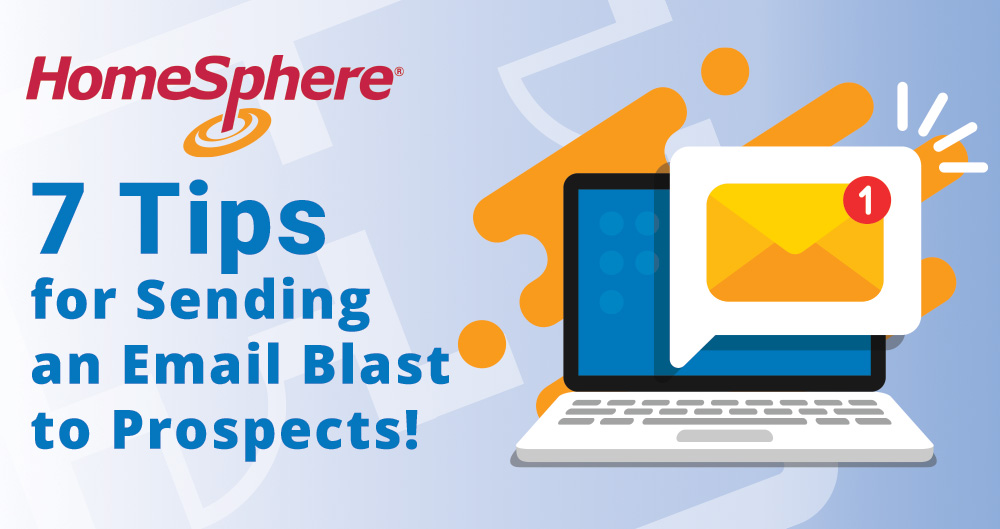Sending an Email Blast to Prospects? Try These 7 Tips First.
March 12, 2020

Emails are undoubtedly effective when done right, but sometimes an email blast misses the mark. To help you avoid this, we’ve gathered the people at HomeSphere with the most to say about email marketing — our marketing team. Here are their seven tips on creating more engaging emails.
To start, check out these older posts:
Manufacturers: Basic Email Best Practices for Building Product Manufacturers
Home Builders: Grow Business Leads through Good Email Lists
Ready? Let’s go.
Start with a good subject line
Subjective, maybe. But there are some baselines: subject lines should be short, descriptive and interesting. “If it’s boring or not descriptive, I won’t open it,” Heather Smiles, HomeSphere’s product marketing manager, said. “It’s best if you can tie your subject line to pain points or tangible business benefits too.”
You won’t always know what resonates with your audience, so Tracy Fletcher, our marketing specialist, suggests A/B testing subject lines as well. As long as the sample size is large enough (generally more than 1,000 contacts), an A/B test helps determine which subject line will result in more opens. You might be surprised by what you find.
Have a clear call-to-action
You’ll get better results from your email blasts if you’re clearly directing the reader to an action. As Sam Stephens, our lead generation specialist, says, “Keep it short and get to the meat of what you want most.” For him that typically means: Pitch yourself, make your request, sign off and then send.
And when it comes to layout, Rico Burnett, HomeSphere’s UX design and marketing specialist, will tell you it’s imperative to put your CTA “above the fold.” That just means that a reader should be able to see your call to action without scrolling.
Burnett will also tell you that attaching a sense of urgency to your CTA will more successfully drive readers to action.
Not yet a HomeSphere partner?
HomeSphere connects residential construction builders with building product manufacturers to facilitate long-lasting relationships through our award-winning platforms, My HomeSphere™ and HomeSphere-IQ®.
Write as little or as much as you need to
Which is just to say, customize the length of your email depending on your message and audience — there is no hard or fast rule about word count. If you’re making a simple request of your reader (i.e. “Please take our survey”), keep it short and sweet. If you're introducing a new product, it’ll depend on how complex the product is. “You don’t want to overwhelm your reader with text, but you also don’t want to be too vague so there’s no hook,” Katherine Wartell, our content marketing specialist, said.
Home builders, your product is visual and your homebuyer prospects will primarily want photos and the important details like price, location and sought-after features. Manufacturers, you might need to include a little more background on your new products so home builders understand the value of them. You’ll know your message didn’t resonate — and needs to be re-worked — when your email gets no response.
Touch on pain points
Don’t take a “me, me, me” approach to your message — that won’t resonate. Some advice from Burnett: “Express how your product or service creates a solution for your audience."
This goes back to touching on pain points. Put yourself in the shoes of your recipient and think about what’s important to them, not what you assume is most important. “Sometimes, there’s a gap in messaging where marketers and sales reps believe they’re pitching the coolest features about a product or service, when, in reality, that feature isn’t actually make or break for a prospect,” Smiles said.
So, how do you know what will appeal the most to your audience? Research, test your message and talk to your target customers.
Personalize your message
Here’s a tip straight from Liz Polson, our director of marketing: “Be as personalized as possible.”
While email blasts generally go out to a large audience, you can still add personalization details that make all the difference. Use tags to include the reader’s first name or other personal information (like their company name, etc.) to appeal to each reader directly.
This means you’ll need to have good contact information to populate these fields. (If you don’t even have a contact’s first name, they probably shouldn’t be on your “send to” list.)
Think about the visuals
Don’t forget how important visuals are to your email’s overall feel. They can draw people in or push them away.
While you’ll have real images of your products, be it a house or an HVAC, it’s also worth it to have high-quality stock images on hand when a stand-out header image is needed. Just keep in mind that you’ll want to choose images that appeal to your prospects.
For example, millennial homebuyers probably won’t respond to images of a 65+ couple standing happily by a "for sale" sign.
Stay on brand
That is, all your emails should look consistent. That doesn’t mean they always have to follow the same layout, but they should have enough of a brand identity that readers can recognize your emails on looks alone.
Toward that, use consistent brand colors, the same fonts and stylistic details, as well as high-quality logos.
Did we miss anything? Let us know!






